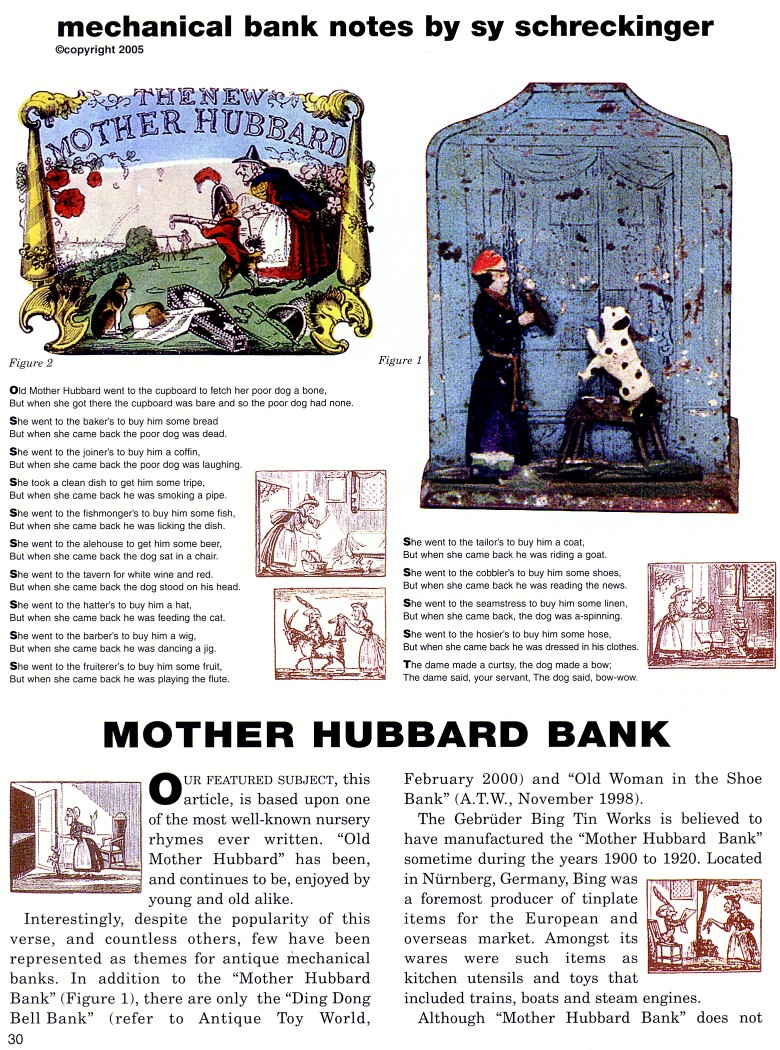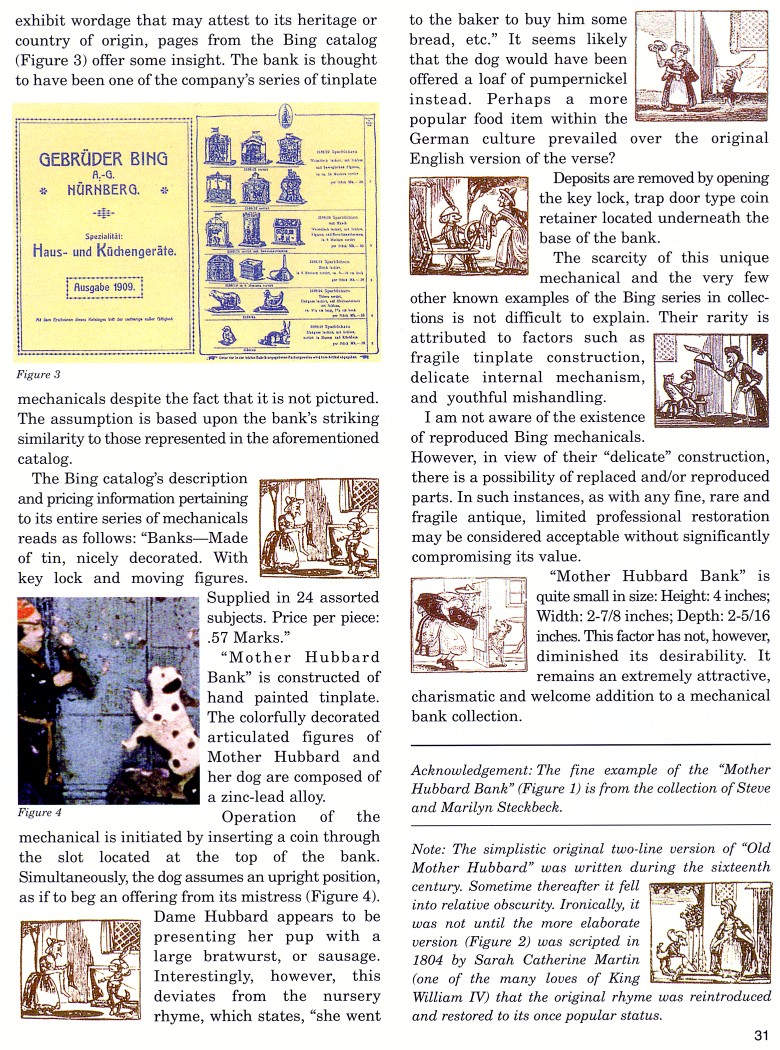|
Mother Hubbard Bank
by Sy Schreckinger – ANTIQUE TOY WORLD Magazine – September, 2005
Old Mother Hubbard went to the cupboard to
fetch her poor dog a bone,
But when she got there the cupboard was bare and so the poor dog had none.
She went to the baker's to buy him some bread
But when she came back the poor dog was dead.
She went to the joiner's to buy him a coffin,
But when she came back the poor dog was laughing.
She took a clean dish to get him some tripe,
But when she came back he was smoking a pipe.
She went to the fishmonger's to buy him some fish,
But when she came back he was licking the dish.
She went to the alehouse to get him some beer,
But when she came back the dog sat in a chair.
She went to the tavern for white wine and red.
But when she came back the dog stood on his head.
She went to the hatter's to buy him a hat,
But when she came back he was feeding the cat.
She went to the barber's to buy him a wig,
But when she came back he was dancing a jig.
She went to the fruiterer's to buy him some fruit,
But when she came back he was playing the flute.
She went to the tailor's to buy him a coat,
But when she came back he was riding a goat.
She went to the cobbler's to buy him some shoes,
But when she came back he was reading the news.
She went to the seamstress to buy him some linen,
But when she came back, the dog was a-spinning.
She went to the hosier's to buy him some hose,
But when she came back he was dressed in his clothes.
The dame made a curtsy, the dog made a bow;
The dame said, your servant, The dog said, bow-wow.
Our featured subject, this article, is based upon one of the
most well-known nursery rhymes ever written. "Old Mother Hubbard" has
been, and continues to be, enjoyed by young and old alike.
Interestingly, despite the popularity of this verse, and countless
others, few have been represented as themes for antique mechanical banks.
In addition to the "Mother Hubbard Bank" (Figure 1), there are only the
"Ding Dong Bell Bank" (refer to Antique Toy World,
February 2000) and "Old
Woman in the Shoe Bank" (A.T.W.,
November 1998).
The Gebruder Bing Tin Works is believed to have manufactured the
"Mother Hubbard Bank" sometime during the years 1900 to 1920. Located in
Nurnberg, Germany, Bing was a foremost producer of tinplate items for the
European and overseas market. Amongst its wares were such items as kitchen
utensils and toys that included trains, boats and steam engines.
Although "Mother Hubbard Bank" does not exhibit wordage that may
attest to its heritage or country of origin, pages from the Bing catalog
(Figure 3) offer some insight. The bank is thought to have been one of the
company's series of tinplate mechanicals despite the fact that it is not
pictured. The assumption is based upon the bank's striking similarity to
those represented in the aforementioned catalog.
The Bing catalog's description and pricing information pertaining to
its entire series of mechanicals reads as follows: "Banks—Made of tin,
nicely decorated. With key lock and moving figures. Supplied in 24
assorted subjects. Price per piece: .57 Marks."
"Mother Hubbard Bank" is constructed of hand painted tinplate. The
colorfully decorated articulated figures of Mother Hubbard and her dog are
composed of a zinc-lead alloy.
Operation of the mechanical is initiated by inserting a coin through
the slot located at the top of the bank. Simultaneously, the dog assumes
an upright position, as if to beg an offering from its mistress (Figure
4). Dame Hubbard appears to be presenting her pup with a large bratwurst,
or sausage. Interestingly, however, this deviates from the nursery rhyme,
which states, "she went to the baker to buy him some bread, etc." It seems
likely that the dog would have been offered a loaf of pumpernickel
instead. Perhaps a more popular food item within the German culture
prevailed over the original English version of the verse?
Deposits are removed by opening the key lock, trap door type coin
retainer located underneath the base of the bank.
The scarcity of this unique mechanical and the very few examples of
the Bing series in collections is not difficult to explain. Their rarity
is attributed to factors such as fragile tinplate construction, delicate
internal mechanism, and youthful mishandling.
I am not aware of the existence of reproduced Bing mechanicals.
However, in view of their "delicate" construction, there is a possibility
of replaced and/or reproduced parts. In such instances, as with any fine,
rare and fragile antique, limited professional restoration may be
considered acceptable without significantly compromising its value.
"Mother Hubbard Bank" is quite small in size: Height: 4 inches;
Width: 2-7/8 inches; Depth: 2-5/16 inches. This factor has not, however,
diminished its desirability. It remains an extremely attractive,
charismatic and welcome addition to a mechanical bank collection.
Acknowledgement: The fine example of the "Mother Hubbard Bank"
(Figure 1) is from the collection of Steve and Marilyn Steckbeck.
Note: The simplistic original two-line version of "Old Mother
Hubbard" was written during the sixteenth century. Sometime thereafter it
fell into relative obscurity. Ironically, it was not until the more
elaborate version (Figure 2) was scripted in 1804 by Sarah Catherine
Martin (one of the many loves of King William IV) that the original rhyme
was reintroduced and restored to its once popular status.
|

